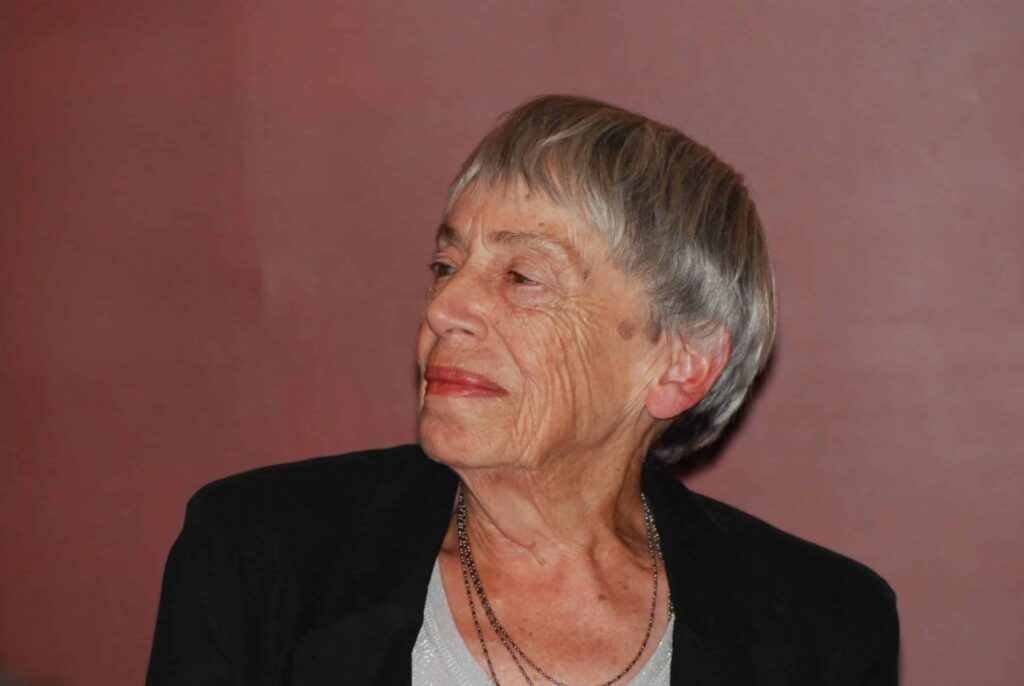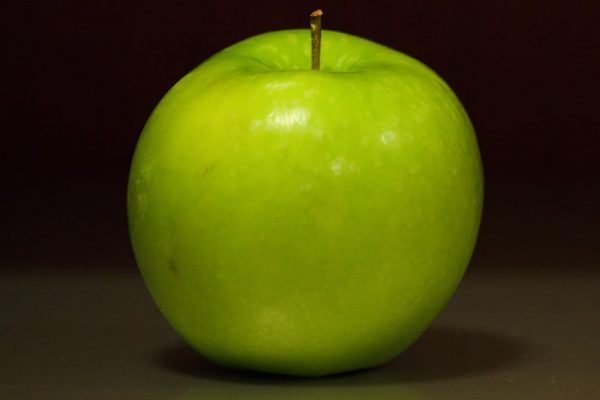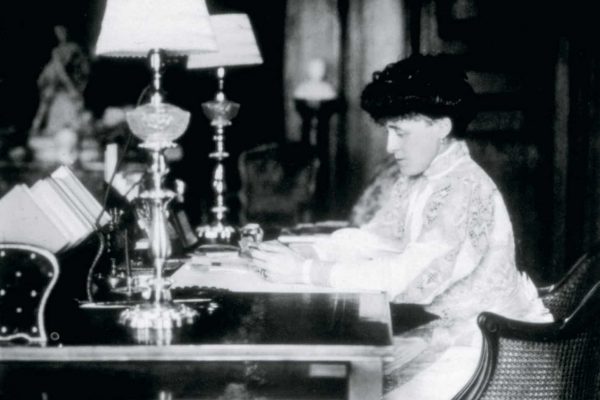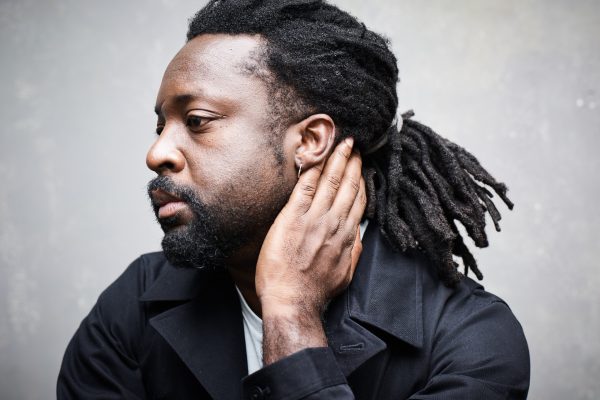Fifty years ago Ursula K. Le Guin’s The Lathe of Heaven entered a world witnessing the once-hopeful dreams of the sixties curdling into the nightmare of neoliberal capitalism. First published in 1971, the novel puts Le Guin’s distinctively artful combination of psychological and sociological themes with dynamic science fiction storytelling on full display, imagining a world in which dreaming could quite literally effect massive social change, for good as well as for ill. In its own moment, this message carried a cutting critique of hippie political idealism: while John Lennon was busy the same year singing, “You may say I’m a dreamer / but I’m not the only one,” the growing reality of fracturing left-wing movements unable to carry out mass social change was becoming more apparent by the day. Reread today in our own moment of accumulating crises, The Lathe of Heaven invites us to reflect on the necessary but slippery role of radical imagination in the arsenal of progressive social movements, rendering dreams both an essential source of hope and a potential site for wishful thinking or frightful authoritarian deformation.
The book’s core premise is simple. George Orr, living in a nightmarish world of ecological collapse, mass starvation, and political violence eerily reminiscent of our own, discovers a unique talent: the ability to remake reality through the power of what he calls “effective dreaming.” Wracked with guilt over his ability to transform his surroundings so dramatically (first discovered as a child, when he inadvertently killed his aunt), Orr attempts to contain this power though dream-suppressing medication, which catches the attention of medical authorities. Forced into mandatory sleep therapy, his oneirologist Dr. William Haber soon wields Orr’s worldmaking abilities to create a better world—at least, as he imagines it—by way of hypnotic suggestion, an approach that leads to countless unanticipated side effects. The path to a better world, the novel suggests, is not so straightforward, even when it is paved with good intentions.
This essay is featured in Uncertainty.
The central dilemma lies in how to interpret the instructions Dr. Haber gives to Orr. The conscious mind might make one thing of an injunction to end human conflict—as Haber instructs Orr to dream at one point—but the unconscious is never so simple. At rest, our brain takes imaginative leaps; it finds ways of recombining waking reality in unlikely or even impossible formations, finding plasticity and elasticity where the waking, rational mind so often misses it. Coaxed through Haber’s powers of suggestion to deliver a better world, Orr’s dreamscape instead bends and feints, finding ways to match the doctor’s formal commands even as it creates a world he did not intend.
In this sense, The Lathe of Heaven meditates on Le Guin’s Taoist principles. Le Guin, who also produced a translation of the Tao Te Ching, has Orr embody a noninterventionist perspective in the novel. He mainly feels disinterest toward his world-changing gift; his preference would be simply to never use it. When his efforts to suppress his dreaming prove unsuccessful, he opposes Haber’s attempts to weaponize and instrumentalize his power.
Orr is wiser than Haber about how difficult it is to align conscious desire with the unconscious’s uncertainty, and how this will invariably cause Haber’s instructions to backfire. Orr’s own imagination proves, again and again, incapable of conceiving of the hopeful outcomes he’d still like to see:
You said, no killing of humans by other humans. So I dreamed up the Aliens. Your own ideas are sane and rational, but this is my unconscious you’re trying to use, not my rational mind. . . . You’re trying to reach progressive, humanitarian goals with a tool that isn’t suited to the job. Who has humanitarian dreams?
As Orr suggests, imagination is at once a fount of incredible optimism and a stubborn realm in which latent fear and anxiety can manifest. Political philosopher Fredric Jameson’s observation that “it has become easier to imagine the end of the world than the end of capitalism” crystallizes this dilemma: while the revolutionary project must claim the mantle of dreaming up better worlds to come, we are also fighting against the tide—not just figuratively but literally, in the face of ever more terrifying climate change.
Of course, Le Guin is not the only person who’s been fascinated by the realm of the unconscious as a site for social and political exploration. Whether in the psychedelic politics of sixties guru Timothy Leary, the magical realist-inflected Marxism of writer Andy Merrifield, or the similar effort made in cultural critic Mark Fisher’s Acid Communism (unfinished at the time of his death in 2017), an effort to blend the surprising imaginaries of unconscious thought with rigorous political action has been a constant theme of the past half-century’s utopian radicalisms. All of these divergent projects reveal similar tensions, namely a concern with solipsistic exploration and the need to plug individual insights about the unknown into a larger framework for social change. In that sense, The Lathe of Heaven is a natural touchstone in this conversation, modeling the messy challenges wrought by dabbling with unconscious forces beyond our control.
Beyond the specific unloosening of reality that’s carried out in sleep, The Lathe of Heaven is also a good reminder that our politics deserve a greater level of imagination, play, and creativity than we often afford them. Without making an end-run around the material conditions we face, as Dr. Haber attempts to do by wielding Orr’s effective dreams with blunt force, there are nonetheless plenty of ways we can approach politics differently—if we are willing to enact a degree of chance or even chaos to unsettle the encrustation of a lifeless realism.
That’s the main thrust of Merrifield’s study Magical Marxism: Subversive Politics and the Imagination (2011). Merrifield reads Gabriel García Márquez’s One Hundred Years of Solitude (1967) alongside philosopher Guy Debord’s Society of the Spectacle (1967) to inject magical realism into an analysis of the image-saturated reality that Debord diagnosed four years before The Lathe of Heaven was published. As Merrifield suggests, it’s not as if we cannot already begin to access different realities within our own “if we look hard enough; it’s just a question of changing one’s perception about what reality is, about what politics is, about what it can be, ought to be.” But where contemporary Marxists are often content to revel in the dour “realism of critical negativity,” sharpening a critique of a society whose failed state is no secret to anyone suffering through it today, Merrifield insists that Marxists can remain critically engaged while expanding their power to conjure unforeseen worlds.
This move is not new to Marxism. Karl Marx himself, on a poetic streak in The Eighteenth Brumaire of Louis Bonaparte (1852), argued that the movement should fight to create a “poetry of the future.” Central to this struggle is a battle over our dreams, a realm haunted by our greatest fears of what may be and leavened by untold possibilities yet to be realized. Merrifield suggests that dreaming and magical realism are both capable of pushing us past a dry materialism: “Magical Realism has as its muse actual reality, yet converts this often stark reality into fantasy, into fantastic and phantasmal subjective visions that become more real than objective reality itself.” Willfully giving up control over reality, as we do in dreaming, is not an easy proposition. Still, given the lack of a stable future in an era of climactic chaos, our ability to anticipate what comes next will be tested in ways that demand more room for unpredictability.
At its best, dreaming up new worlds is a collective process, an undertaking too vast for one person to handle alone. That’s the vision of poet Renee Gladman and artist Edie Fake in their shape-shifting, otherworldly Paris Review piece “Cities of the Future, Their Color”: with our old images of futuristic cities now “codified and photographed and renovated,” their productive capacities to remake reality now spent, the “cities of the future came to everyone one night in our sleep,” inviting new opportunities to reflect on remaking the worlds we inhabit. The future cities imagined by Gladman and Fake are an invitation to find hope in what might become, and to hold a thoughtful mirror to present-day shortcomings. In dreaming up such unrealized cities, one has “to be speculative” while bearing in mind what is “actually happening on your streets, in your bodies, and between bodies,” in a way that recalls the thread of imagination-in-collective-action that ran through the uprisings of summer 2020. While everyday reality often dampens the spirit of creation—makes it impossible to believe that positive change can be sustained—being in conversation with the dreams of others is a path toward rekindling a radical movement brimming with joyful co-creation of heretofore unrealized realities.
The Lathe of Heaven does not allow us to consider how a collective dream process might unravel currently existing reality, as the world-remaking power of dreaming is rooted only in Orr’s unconscious. But it does offer an explicit critique of Dr. Haber’s solipsistic certainty that dictating Orr’s dreams is the best vehicle for positive change. Le Guin makes Orr into a beatific, Taoist embodiment of noninterventionism, one who understands that meddling with powerful unconscious forces is an easy path toward self-destruction. Orr’s first uncontrolled effective dream as an adult comes as he and everything around him stands at the brink of final collapse: with the country run as an authoritarian police state, the population thinned by multiple epidemics and mass starvation, Orr collapses at the edge of the city, certain he won’t wake up the next day. While the reality he faces the next morning cannot erase many of the failures of what came before, Orr’s unconscious is still capable of conjuring a world ever-so-slightly more livable than where he came from, itself a miracle that leads him to despair at the thought of changing conditions any further.
After suppressing dreaming for a time, Orr’s imagination is wielded by Dr. Haber, to increasingly dire outcomes. Instructed to dream a less overcrowded world, Orr creates a plague which kills 6 billion people; encouraged to eliminate human conflict, Orr conjures an alien threat that unites humanity in a common cause. He eliminates racial differences by turning the entire population into a gray, undifferentiated whole, in the process disappearing Heather Lelache, a mixed-race woman with whom he is in love. Each iteration pushes the world further from where it needs to be, and Orr begs Dr. Haber to reconsider his rationalist approach:
We’re in the world, not against it. It doesn’t work to try to stand outside things and run them, that way. It just doesn’t work, it goes against life. There is a way but you have to follow it. The world is, no matter how we think it ought to be. You have to be with it. You have to let it be.
Orr’s pleading is to no avail, and the book ends with the planet forever unsettled by the mixed realities enacted by too much meddling. Frustrated by Orr’s continued resistance, Dr. Haber eventually trains his own brain to dream effectively, but loses his mind to the knowledge of countless overlapping worlds. Earth is thereafter layered with multiple timelines at once, with aliens now settled on the planet as an everyday presence.
In that sense, the final, jumbled world of The Lathe of Heaven enacts the Zapatista philosophy of building “a world where many worlds fit,” with the eventual creation of a more enduring, if confusing, environment still better than the one that Orr first unconsciously sought to change. Yet the many conscious interventions made in between, all in the name of positive social progress, are ultimately a force for incredible harm. It’s a challenging, unsettling proposition for those who might look to Le Guin for political guidance. Can we really let the world be when the entire future of our planet seems to hang in the balance? Such questions have only grown more dire in the half century since the book was written; even at its release, with the once-flowering hippie political movement wilting at an alarming rate, Le Guin seemingly understood how vital these questions were to the longevity of radical political movements.
Le Guin’s novel emerged at a moment—1971—when the reality principle of a stable and enduring capitalism had proven highly vulnerable. Loosened by a flood of LSD and other psychedelic drugs that remapped culture and politics in the late sixties, many suburban-bred white teenagers found themselves unmoored from their parent’s Protestant work ethic and cultural conservatism, just as Black Power and decolonial movements haunted the forces of global capital. If their defection from what economist John Kenneth Galbraith called “the affluent society” could be made permanent, young white people were primed to play a vital sustaining role in deepening this state of revolt into lasting societal change, their perception of the possible expanded by chemicals that exposed the fundamental brittleness of what surrounded them.
In this tempest of sixties psychedelic radicalism, there was no one more willing to anoint himself with god-like (or at least prophet-like) powers than Timothy Leary. Charismatic, endlessly quotable, the Harvard researcher and psychonaut became the figurehead of psychedelic consciousness both within and outside the hippie subculture. To his believers, he was a heroic figure, pushing the boundaries of human consciousness at unprecedented speeds; to his foes, he was a wanted man, just as dangerous as the Black Panthers, particularly for his influence on white youths.
But Leary’s vision was cloudy when it came to the enduring materiality of racial capitalism in the United States, a limitation that became clear while he was in exile in Algeria, camped out with a sect of Black Panthers who’d offered him refuge. In one sense, Leary’s infamous mantra—“Turn on, tune in, drop out”—aligned him with the kind of Taoist noninterventionism encouraged in The Lathe of Heaven. But in reality, Leary’s insistence on nonaction foundered on the growing backlash to the era’s radical tempest, as he underestimated just how rooted the conservative beliefs ran within the U.S. unconscious, the kind of lingering communal belief system that makes a nightmare of even our most hopeful fantasies.
Even before he fled the United States, Leary had already argued against mass political action as the next step for the counterculture. In a debate published after the 1966 Love Pageant Rally in San Francisco, Leary pushed against poet Allen Ginsberg and Buddhist philosopher Gary Snyder, who exhorted the movement to become more engaged. By contrast, Leary preached inner change: “I think they should be sanctified, drop out, find their own center, turn on, and above all avoid mass movements, mass leadership, mass followers.” Whatever path was chosen, the road ahead remained open in that moment, the large-scale gatherings of disaffected youth seeming to stand for radical transformation just around the corner.
The mood had soured just five years later: Richard Nixon was at the height of his powers, the Vietnam War raged on, and political repression had eroded much of the material gains of the Panthers and other radical formations. Despite that, Leary continued to insist on an individualized, drug-oriented form of oppositional consciousness. The limitations of this approach are strikingly revealed in a 1971 issue of underground paper Berkeley Tribe, in which Black Panther leader Eldridge Cleaver challenged Leary’s vacuousness in an interview carried out in Algiers, where the Panthers shielded Leary and his wife in exile.
Cleaver is clear that psychedelics were vital to radicalizing young white people whose lives were otherwise a million miles away from the material deprivation faced by Black America. But if psychedelics cracked open reality for so many, it was only a first step, not itself capable of unmaking the solid stubbornness of racial capitalism. As he argued:
We do recognize the progressive role played in the past by the whole youth, drug, culture in the United States. It was very useful some years ago when people rebelled against the straitjacket rules and regulations of Babylonian society by turning away from the standards and values of that society, and by shattering to smithereens those values by getting high, freaking out, freaking off. . . . But things have changed since then. . . . We want people to gather their wits, to sober up, and get down to the serious business of destroying the Babylonian empire.
Chiding Leary, Abbie Hoffman, Jerry Rubin, and other white leadership for leaving their constituency in limbo, Cleaver recognized how the absence of a reality principle capable of filling the void opened by psychedelic consciousness left these young people vulnerable to empty navel-gazing. Especially as other elements of white-led radical movements such as the Weather Underground opted for spectacular violence to disrupt U.S. society, the lack of a middle path between outward social engagement and inward emotional transformation proved a significant undoing for the era’s mass social upheavals. Threading such large-scale change between these competing influences would be a daunting task for any era of political radicals, of course; the added instability unleashed by psychedelics proved even more challenging.
The lack of sustainable connective tissue between Leary’s individualistic approach to social change and the wider political movements of the era cannot be undone. Fortunately, there are some today who understand the value of seeking inner transformation on the way toward broader social transformation, recognizing that people are inherently changed by the process of struggling for a better world. That perspective is well embodied in the work of Reverend angel Kyodo williams, a Black queer Zen Buddhist instructor based in the Bay Area. In her book Radical Dharma: Talking Love, Race, and Liberation (2016), coauthored with Lama Rod Owens and Jasmine Syedullah, williams seeks to define a more balanced approach. “Without inner change,” she writes, “there can be no outer change; without collective change, no change matters.” Kyodo’s patient, socially minded Buddhism is an invitation to continue seeking social change even when it feels as if our own actions can accomplish nothing. It is a method of guiding and shaping change without imposing our will, as Dr. Haber tries to do.
Difficult as it may be, there are still ways of threading these radical alternative political models into the existing organizing work carried out today. A clear counterpoint to Merrifield’s Magical Marxism and Williams’s Black, queer Buddhism is Acid Communism, the unfinished last book of influential Marxist cultural theorist Mark Fisher. As his title suggests, Fisher was seeking a through line in the many potentials unearthed by sixties counterculture, finding within various social, cultural, and political formations of the era a model of abundance that challenged capitalism’s endless artificial scarcity.
Fisher proposes that a primary task of neoliberalism has been imposing what he calls “capitalist realism,” or the false certainty that alternatives to our current economic model are “unthinkable.” Memory of the sixties terrifies those who wish to maintain this repression, Fisher explains: “the decade haunts not because of some unrecoverable and unrepeatable confluence of factors, but because the potentials it materialized and began to democratize—the prospect of a life freed from drudgery—has to be continually suppressed.” Fisher’s interest in acid was less focused on its effects on individual consciousness and more on its widespread impacts on working-class culture, creating a sensibility that principles of free cultural expression and effective communal organization could be found. In the decades of neoliberalism that followed, Fisher suggests that “the failure of the left . . . had much to do with its repudiation of, or refusal to engage with, the dreamings that the counterculture unleashed.” Unable to build a solid foundation on the shifting sands of a psychedelic culture that lacked deep roots in U.S. culture, and absent the kind of patient orientation to change that both Williams’s Buddhism and Le Guin’s Taoism encourage, we are instead left to remember this era with fading clarity.
Is there still time left for us to dream? A silly question, perhaps. And yet: everything about our politics today—from the looming danger of fascist violence to the seemingly inevitable destruction wrought by climate change—seems to necessitate an urgent response that pushes against our ability to slow down, let our minds wander, and simply conjure other worlds yet to be made. When crisis after crisis is not addressed, and the mere act of surviving each day is its own nightmarish struggle, allowing ourselves to dream can feel self-indulgent, trivial, the kind of luxury we deserve but are rarely afforded.
And yet dreams come to even the most run-down, burnt-out, flat-out-exhausted human being. What does it suggest about humanity that, however much we are subjugated, other worlds are always at hand in the quiet of night? In interviews, Le Guin pointed to other works, particularly the anarchist space colonies of her 1974 novel The Dispossessed, as her most political. But what if we held The Lathe of Heaven in that same space, considering what it means for how we think about politics? If nothing else, The Lathe of Heaven suggests that our dreams are best hashed out with others—that our individualistic fantasies, however expansive, are best actualized when meshed in conversation and collaboration, rather than cloistered in the narrow-minded pursuit of a single tendency or practice.
Recognizing the multiplicity of dreams that must be actualized is already at the core of many radical practices, as the Zapatista “world where many worlds fit” philosophy would suggest. Far more challenging is the act of moving in dialectical fashion from a dream state to waking existence, synthesizing a mixture of the two that neither delimits our imagination nor erases the hard work yet to be done of materially changing our surroundings. After a half century of being told that the radical demand for a transformed social and economic order was nothing more than a series of empty illusions, the choice to keep dreaming, even as we plant both feet firmly on the ground and in the streets, is exactly the kind of radical practice Le Guin would be proud of. As she suggested just a year after The Lathe of Heaven in her novella “The Word for the World is Forest” (1972): “Once you have learned to do your dreaming wide awake, to balance your sanity not on the razor’s edge of reason but on the double support, the fine balance, of reason and dream; once you have learned that, you cannot unlearn it any more than you can unlearn to think.”








